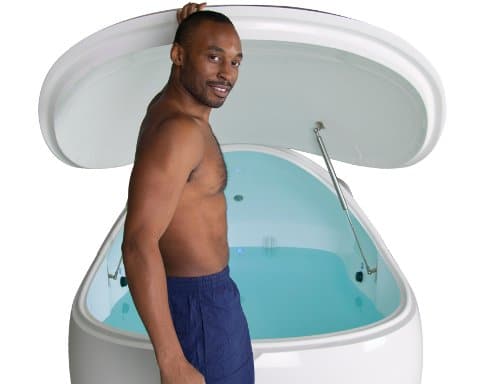Floating for sports rehabilitation and enhanced performance
Accelerate rehabilitation from injury, reduce recovery times between activity, and get an extra edge in performanceFloating for sports
Sports rehabilitation, recovery and performance
Many different types of sports people use floatation to accelerate rehabilitation from injury, to reduce recovery times between activity, and to get an extra edge in performance.
Floating can be used as part of a regular training programme, in preparation for a specific event, and for rapid recovery after.

Be the best you can be
Many elite professional teams around the world have incorporated regular floating into their training programmes. This practice goes across all kinds of sports from Football to Golf and from Rugby to Track and Field.
Furthermore, floatation has been used by some of the most successful Olympians. Philips Idowu, Tasha Danvers and Jade Johnson and Carl Lewis have all used floatation to great success.
But you certainly don’t have to be an Olympian to appreciate the benefits of floating. Whether you are into an activity to improve fitness, to achieve personal goals, to compete and to win, or finally just for fun, floating can help you.
Whichever sport is your passion, floatation can help :
Break down lactic acid more quickly
Accelerated recovery from exertion
Return faster after injury
Increased circulation
Reduced heart rate
Reduced corstisol
Natural pain relief
Reduced likelihood of injury
Reduced levels of adrenalin
Enhanced awareness of your body
An opportunity to be calm and focused
An ideal environment for visualisation

Quicker Recovery

You need to rest
Alongside the right training programme and the right diet, rest is vital to athletic success.
Floating gives you the ultimate rest, and as a result, it delivers rapid recovery.
Being suspended in a saturated solution of Epsom salt improves circulation, consequently increasing the blood flow throughout the body.

Pressure on your body
When your body is resting on any surface, even the softest mattress, the pressure restricts the blood flow in the muscle groups in contact with it.
During floatation the body is buoyant, which means that the weight is spread across almost the whole surface area of the skin.
The capillaries are able to dilate in the absence of any compression. What’s more, this dilation is further enhanced by the warmth of the salt solution.
This ensures that the skeleto-muscular system receives what it needs to get you back into peak condition in the shortest time possible.

Practically ‘anti-gravity’
Floating removes many of the physiological effects of gravity.
This allows the muscles to relax completely, so they can truly rest. Similarly, the strains on bones, joints and tendons due to gravity are removed.
Lactic acid is removed from body tissues more rapidly, reducing fatigue and muscle ache. Finally the levels of the stress hormone cortisol are reduced, and also adrenalin.
As a result, your body is ready for action again. Floating enables you to get back to doing what you love sooner.

Proper sports rehabilitation
Integrating floating into your training programme allows for proper sports rehabilitation.
Floating empowers you to train more often and more intensively, and in the most effective way.
Float in the Forest can help you be the best you can be.

Faster return from injury

Brett’s inspiring story
Brett Dennis was a young and promising cyclist. Then in 1994 he fell from a cliff and smashed his femur during the US Tour DuPont road race.
Doctors gave him little chances of full recovery.
He used floatation 3 times a week. After 7 weeks of floatation therapy he won gold.
Consequently he and his team mates beat the Australian record in the 100 km team time trial.

Float to recover from injuries, and even to prevent them
As already mentioned, floatation effectively removes the effects of gravity on the body. This alleviates compensatory muscle tensions and as a result, it helps to break the pain cycle. Consequently your body can focus on injury repair and muscle growth.
Have you noticed that injury often coincides with when you are ‘up tight’?
Floatation offers not only an earlier return from injury, but the reduced muscle tension leads to a reduced risk of future injury.
This is because when you move in a loose and relaxed way, you are adopting the best defence against injury.
The unparallelled level of relaxation that floating offers can persist for days afterwards.


Greater body awareness
When you float, external stimuli such as light and sound are minimised. If you prefer, of course you can leave the light on or the door open – you are in control.
However, the complete absence of stimili has a powerful effect. As a result, your attention is directed at the only remaining stimuli: the body and mind.
Therefore floatation brings you into a closer relationship with your body and consequently can be an opportunity to find greater body awareness.
By becoming more aware of your body you can notice any subtle stresses and strains early on.
This enables you to fine-tune your technique and change your training behaviour to prevent injury, whether that means knowing when to slow down, or perhaps where to focus your stretching.

Enhanced Performance

Visualise yourself among the greats
Elite athletes know that success begins in the imagination. Above all, getting your ‘mental game’ right is at the heart of achieving your goal. Sometimes called neuro-muscular programming, visualisation is a tried and tested technique of sports psychology.
What’s more, greats such as Muhammad Ali, Jonny Wilkinson, Wayne Rooney and Andy Murray have all said how important visualisation has been in their career.

Visualisation while floating
To be truly effective, visualisation involves all your senses in a detailed mental rehearsal of the physical actions. The more relaxed you are, the more clear and controllable the mental imagery becomes, and the more effective the result.
Floatation is the ultimate environment for relaxation. The floatation environment leads to an increase in theta waves in the brain. This is the optimum state for positive suggestions and visualisation to work.
Dr Peter Suedfeld from the University of British Columbia in Vancouver carried out some research with basketball players. He measured their performance a day before and after a single session of floating and visualisation. The experiment revealed a 37% improvement in free throws compared to the control group.
By performing visualisation exercises in the silent darkness it is possible to achieve a rapid improvement in performance.
Floating can give you:
Reduced muscle tension and therefore improved fine motor skills and accuracy.
Ultimate relaxation, which means less wasted energy, leading to improved stamina, speed, and strength.
Improved body awareness, which gives you better coordination and a reduced chance of injury.
A calm mind, which brings increased concentration and focus.
In conclusion
You might dream of seeing yourself crossing the finish line, hearing cheers from the stands, or feeling yourself lifting a heavier weight than ever before…
Relaxation through floatation offers faster return from injury, accelerated recovery, and a path to improved performance.
Remember: the act of creating and rehearsing a positive experience in your imagination translates directly into a positive outcome on the day.



